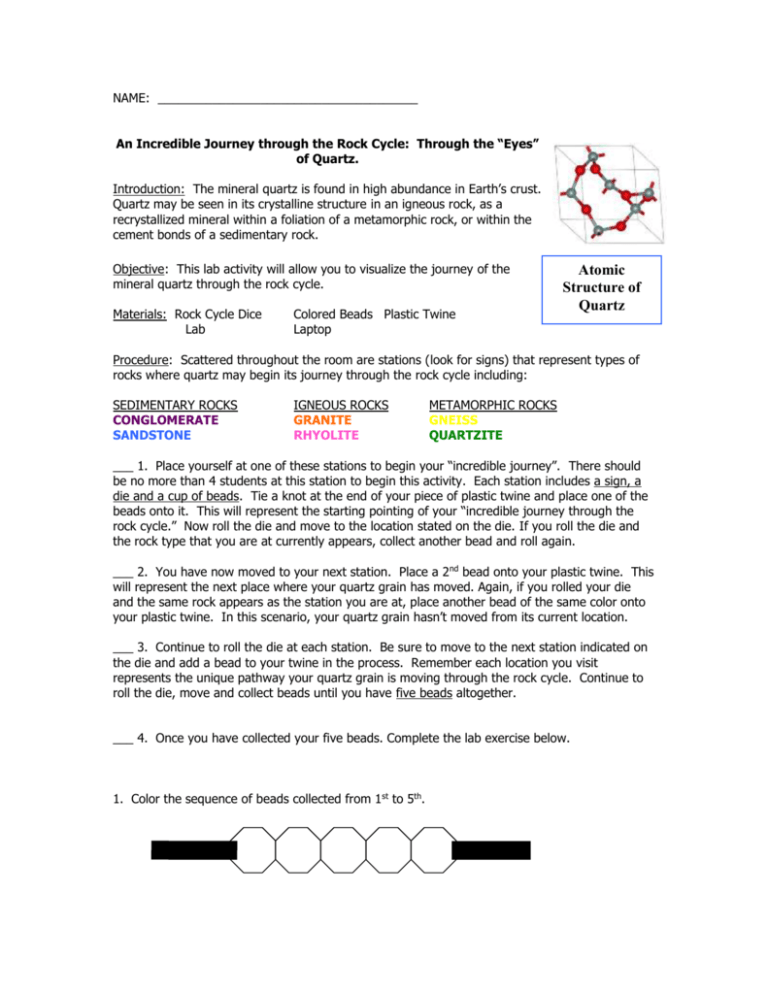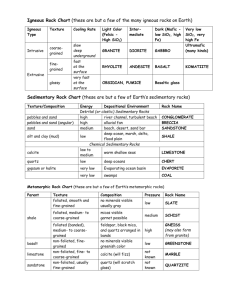Name
advertisement

NAME: ______________________________________ An Incredible Journey through the Rock Cycle: Through the “Eyes” of Quartz. Introduction: The mineral quartz is found in high abundance in Earth’s crust. Quartz may be seen in its crystalline structure in an igneous rock, as a recrystallized mineral within a foliation of a metamorphic rock, or within the cement bonds of a sedimentary rock. Objective: This lab activity will allow you to visualize the journey of the mineral quartz through the rock cycle. Materials: Rock Cycle Dice Lab Colored Beads Plastic Twine Laptop Atomic Structure of Quartz Procedure: Scattered throughout the room are stations (look for signs) that represent types of rocks where quartz may begin its journey through the rock cycle including: SEDIMENTARY ROCKS CONGLOMERATE SANDSTONE IGNEOUS ROCKS GRANITE RHYOLITE METAMORPHIC ROCKS GNEISS QUARTZITE ___ 1. Place yourself at one of these stations to begin your “incredible journey”. There should be no more than 4 students at this station to begin this activity. Each station includes a sign, a die and a cup of beads. Tie a knot at the end of your piece of plastic twine and place one of the beads onto it. This will represent the starting pointing of your “incredible journey through the rock cycle.” Now roll the die and move to the location stated on the die. If you roll the die and the rock type that you are at currently appears, collect another bead and roll again. ___ 2. You have now moved to your next station. Place a 2nd bead onto your plastic twine. This will represent the next place where your quartz grain has moved. Again, if you rolled your die and the same rock appears as the station you are at, place another bead of the same color onto your plastic twine. In this scenario, your quartz grain hasn’t moved from its current location. ___ 3. Continue to roll the die at each station. Be sure to move to the next station indicated on the die and add a bead to your twine in the process. Remember each location you visit represents the unique pathway your quartz grain is moving through the rock cycle. Continue to roll the die, move and collect beads until you have five beads altogether. ___ 4. Once you have collected your five beads. Complete the lab exercise below. 1. Color the sequence of beads collected from 1st to 5th. 2. Complete the data table shown below based on the information provided in your bead sequence. Bead Color Rock What process(es) took place to move your quartz grain from this rock to the next? 3. Using the diagram below, highlight the pathway your quartz grain took through the rock cycle. Synthesis: Using the bead sequence you created and the information you presented in your data table, write a paragraph below describing the “unique journey” your quartz grain took in the rock cycle. Be certain to state and highlight which rocks of the rock cycle your quartz grain was a part of (ex: conglomerate, gneiss, etc…) and what processes occurred to move your quartz grain through the cycle (ex: heat, melting, weathering, cementation, etc…) A word bank has been provided to give you a list of terms you may wish to use in your writing. You are NOT required to use all of these terms. Rock Cycle Terms Sediments Clasts Fragments Magma Lava Sedimentary Igneous Metamorphic Weathering Erosion Deposition Sediment Size (clay, silt, sand, pebbles, cobbles, boulders) Compaction Cementation Melting Cooling Intrusive Extrusive Vesicular Solidification Crystallization Texture Coarse Fine Heat Pressure Recrystallization Foliation Banding Distortion Deformation






